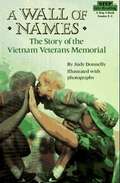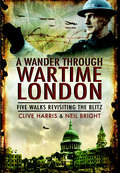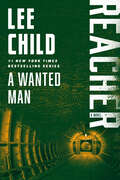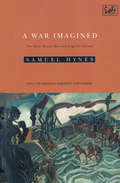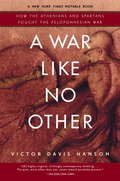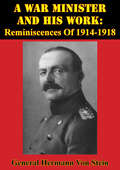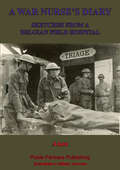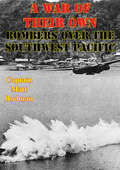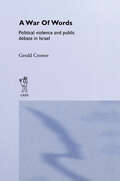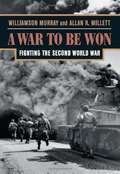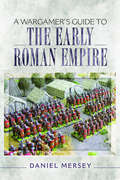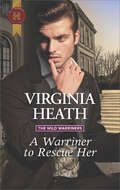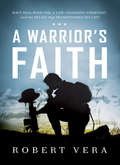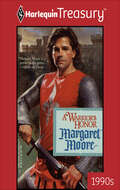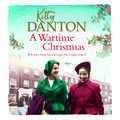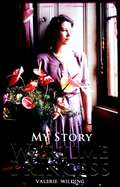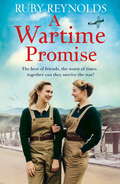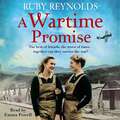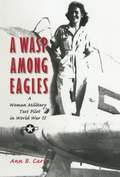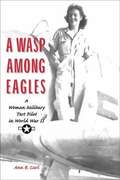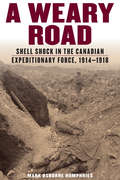- Table View
- List View
A Wall of Names: The Story of the Vietnam Veterans Memorial
by Judy DonnellySurveys the history of the Vietnam War, chronicles the construction of the Vietnam Memorial, and discusses what the Memorial means to many Americans.
A Wander Through Wartime London: Five Walks Revisiting the Blitz
by Clive Harris Neil BrightThrough a series of five walks this book discovers the sights, sounds and experience of the capital at war; it details the remaining tangible evidence of the dark days via air raid shelter signs, bomb damage on buildings and memorials detailing heroic and often tragic events. The new routes cover a wide area of London and reveal further evidence of the experiences of four years air war in the skies above our capital city. The East End & Docks, Greenwich, Holborn, Bermondsey, Southwark and the West End are all featured, along with detailed maps and numerous contemporary photographs that accompany the text for each walk. The book also contains a number of appendices relating to the wider picture of the war. A well deserved story of Londons Home Guard is told. A list of Civil Defense casualties that occurred within the boroughs covered by the walks is included as well as a detailed list of the locations of wartime fire and ambulance stations across the capital.This book will appeal to both the enthusiast and anyone with an interest in Londons past. It is a further record of the memories and tangible evidence of this dramatic period of our capitals past and a tribute to those who lived through the Blitz and sadly so often, those who did not.
A Wanted Man: A Jack Reacher Novel (Jack Reacher #17)
by Lee Child#1 NEW YORK TIMES BESTSELLER • Don&’t miss the hit streaming series Reacher!&“The indomitable Reacher burns up the pages.&”—USA TodayFour people in a car, hoping to make Chicago by morning. One man driving, another telling stories that don&’t add up. A woman in the back, silent and worried. And a hitchhiker with a broken nose. An hour behind them, the FBI descends on an old pumping station where a man was stabbed to death—the knife work professional, the killers nowhere to be seen.All Jack Reacher wanted was a ride to Virginia. All he did was stick out his thumb. But he soon discovers he has hitched more than a ride. He has tied himself to a massive conspiracy, in which nothing is what it seems, and nobody is telling the truth.&“Furious action . . . [Lee] Child keeps the pacing swift and the surprises rolling. . . . [A] feverishly thrilling series.&”—The Miami Herald&“Smart, breathless . . . [with] one of the best female characters in the whole Reacher series.&”—The New York Times&“Subtle and nuanced [with] seductive writing and irresistible plot twists.&”—Newsweek
A War Imagined: The First World War and English Culture
by Samuel HynesBetween the opulent Edwardian years and the 1920s the First World War opens like a gap in time. England after the war was a different place; the arts were different; history was different; sex, society, class were all different.Samuel Hynes examines the process of that transformation. He explores a vast cultural mosaic comprising novels and poetry, music and theatre, journalism, paintings, films, parliamentary debates, public monuments, sartorial fashions, personal diaries and letters.Told in rich detail, this penetrating account shatters much of the received wisdom about the First World War. It shows how English culture adapted itself to the needs of killing, how our stereotypes of the war gradually took shape and how the nations thought and imagination were profoundly and irretrievably changed.
A War Like No Other: How the Athenians and Spartans Fought the Peloponnesian War
by Victor HansonOne of our most provocative military historians, Victor Davis Hanson has given us painstakingly researched and pathbreaking accounts of wars ranging from classical antiquity to the twenty-first century. Now he juxtaposes an ancient conflict with our most urgent modern concerns to create his most engrossing work to date, A War Like No Other.Over the course of a generation, the Hellenic city-states of Athens and Sparta fought a bloody conflict that resulted in the collapse of Athens and the end of its golden age. Thucydides wrote the standard history of the Peloponnesian War, which has given readers throughout the ages a vivid and authoritative narrative. But Hanson offers readers something new: a complete chronological account that reflects the political background of the time, the strategic thinking of the combatants, the misery of battle in multifaceted theaters, and important insight into how these events echo in the present.Hanson compellingly portrays the ways Athens and Sparta fought on land and sea, in city and countryside, and details their employment of the full scope of conventional and nonconventional tactics, from sieges to targeted assassinations, torture, and terrorism. He also assesses the crucial roles played by warriors such as Pericles and Lysander, artists, among them Aristophanes, and thinkers including Sophocles and Plato.Hanson's perceptive analysis of events and personalities raises many thought-provoking questions: Were Athens and Sparta like America and Russia, two superpowers battling to the death? Is the Peloponnesian War echoed in the endless, frustrating conflicts of Vietnam, Northern Ireland, and the current Middle East? Or was it more like America's own Civil War, a brutal rift that rent the fabric of a glorious society, or even this century's "red state--blue state" schism between liberals and conservatives, a cultural war that manifestly controls military policies? Hanson daringly brings the facts to life and unearths the often surprising ways in which the past informs the present.Brilliantly researched, dynamically written, A War Like No Other is like no other history of this important war.
A War Minister And His Work: Reminiscences Of 1914-1918 [Illustrated Edition]
by General Hermann Von SteinIncludes the First World War Illustrations Pack - 73 battle plans and diagrams and 198 photosEven before the advent of the First World War, General Der Artillerie Hermann Von Stein, had had a long and distinguished career in the Prussian Army stretching back to 1873. He served in various artillery and staff posts and rubbed shoulders with the heads of the General Staff such as Von Schlieffen, both Von Moltkes and Von Waldersee (of whom he includes portraits in this volume). In 1914 he was appointed to the 14th Reserve Corps which advanced with 2nd Army as part of the right hook through northern France before being bogged down in the stalemate of the trenches of the Western Front. He and his men were those who stubbornly defended Thiepval during the bloody battle of the Somme in 1916. After his successful field commands he was appointed War Minister for Prussia, a post that he held until the end of the war. His reminiscences offer a little seen view of the German High Command during the First World War.
A War Nurse’s Diary; Sketches From A Belgian Field Hospital [Illustrated Edition]
by Anon.Illustrated with 33 photos of the author's comrades, adventures and hospitals.When war broke out in 1914, it was imagined in Britain that the war with Germany would be short and the need for nursing staff over in France would be low as there should be very few casualties. The author, a trained nurse from the Northern Midlands in England, decided that she would volunteer her services immediately, but was rebuffed by the Red Cross and St John's Ambulance on the basis that they had almost one nurse for every soldier in the field. Not to be deterred, she responded to an advert which read: "Ten nurses wanted at once for Antwerp; must be voluntary." And off to Belgium she went in August 1914.It was to be in Belgium that so many of these rosy presumptions that were held by many were shattered early in the autumn of 1914, as the German steamroller thumped into the Allied forces. In its wake the huge numbers of wounded flooded into the hospitals in Belgium where our author was inundated with work. As the Germans moved forward, she and her fellow hospital staff were moved backward from Antwerp, where she was briefly caught up in the siege, escaping to Ghent, Bruges, Ostend and thence to France. She tended to the wounded amidst the carnage of war almost unceasingly until a year later when she left France for England in October 1915.
A War of Their Own: Bombers Over the Southwest Pacific [Illustrated Edition]
by Captain Matt Rodman[Illustrated with more than 45 diagrams, photos and tables]Captain Rodman, an instructor weapon-systems officer at Dyess AFB, Texas, examines the distinctive nature of Fifth Air Force's role in the air war over the Southwest Pacific Area during World War II. Especially notable is Gen George Kenney's innovative use of light attack aircraft as well as both medium and heavy bombardment aircraft, characterized by theater-specific tactics, ordnance, and structural modifications. A War of Their Own also considers the free exchange of aircraft and missions in the Southwest Pacific a hallmark of that theater; in terms of the conflict between doctrine and tactics that underlay Fifth Air Force's relationship to the prewar Army Air Corps and the postwar Air Force. The author also notes the relevance of the Fifth's experiences to airpower.
A War of Words: Political Violence and Public Debate in Israel (Political Violence Ser.)
by Gerald CromerThis book examines a series of controversies surrounding Israel's use of force and its failure to prevent violence. Influenced by Weber's definition of the state as the 'monopoly of violence', politcial scientists and criminologists alike have focused their attention on the legitimation struggles of non-state actors who resort to violence. This boo
A War to be Won: Fighting the Second World War
by Williamson Murray Allan R. MillettIn the course of the twentieth century, no war looms as profoundly transformative or as destructive as World War II. Its global scope and human toll reveal the true face of modern, industrialized warfare. Now, for the first time, we have a comprehensive, single-volume account of how and why this global conflict evolved as it did. A War To Be Won is a unique and powerful operational history of the Second World War that tells the full story of battle on land, on sea, and in the air. Williamson Murray and Allan R. Millett analyze the operations and tactics that defined the conduct of the war in both the European and Pacific Theaters. Moving between the war room and the battlefield, we see how strategies were crafted and revised, and how the multitudes of combat troops struggled to discharge their orders. The authors present incisive portraits of the military leaders, on both sides of the struggle, demonstrating the ambiguities they faced, the opportunities they took, and those they missed. Throughout, we see the relationship between the actual operations of the war and their political and moral implications. A War To Be Won is the culmination of decades of research by two of America's premier military historians. It avoids a celebratory view of the war but preserves a profound respect for the problems the Allies faced and overcame as well as a realistic assessment of the Axis accomplishments and failures. It is the essential military history of World War II-from the Sino-Japanese War in 1937 to the surrender of Japan in 1945-for students, scholars, and general readers alike.
A Wargamer's Guide to the Early Roman Empire
by Daniel MerseyThe Roman army of the early empire is one of the most instantly recognizable armies and enjoys a reputation for excellence. This and their many famous campaigns against a wide range of colorful foes makes this one of the most popular periods for wargamers. Covering the period from 27BC to AD284, Daniel Mersey gives a wargamers perspective of the many conflicts and offers advice on how to recreate these on the gaming table. Advice is given on factors to consider when choosing an appropriate set of commercially available rules, or devising your own, to best suit the scale and style of battle you want and capture the flavor of the period. The relevant ranges of figures and terrain pieces and buildings are also reviewed. Analysis of the forces involved, organization, tactics and strategies will help with building your armies and there are interesting scenarios included. Whether this is a new period for you, or you are looking to refresh your existing interest in the period, this handy guide is sure to hold much if interest.
A Warriner to Rescue Her: The Wild Warriners (The Wild Warriners #2)
by Virginia HeathA wounded war veteran tries to resist falling for the minister’s daughter in this Regency romance.Tempted by the damsel in distress! Captain James Warriner is startled to find a curvaceous beauty caught up a tree in his orchard! Despite his shattered leg, he rescues Miss Cassandra Reeves, then is determined to have nothing more to do with the enticing vicar’s daughter. Except when Cassie seeks Jamie out to apologize, they find themselves persuaded to work together on her storybook. Secret liaisons with the dashing soldier make Cassie wish Jamie would rescue her once more . . . by making her his wife!
A Warrior's Faith
by Robert W. VeraAn exhilarating story of a young Navy SEAL whose relentless faith transformed his life and inspired everyone who knew his courageous story.In A Warrior's Faith, Ryan Job's close friend, Robert Vera, recounts how the highly decorated Navy SEAL's unstoppable sense of humor, positive attitude, and fierce determination helped him survive after being shot in the face by an enemy sniper on a roof in Ramadi, Iraq. Though blinded, the irrepressible Job recovered from his wounds and began facing a new set of obstacles with his characteristic humor and resolve. He married the girl of his dreams, hunted elk, climbed Mt. Rainier, graduated college with honors, influenced countless people around him, and was looking forward to being a father--before his life was tragically cut short by a hospital medical error.Vera's raw, often funny, and heartfelt account of his friend's life offers readers a way to find hope in the middle of life's raging storms.
A Warrior's Honor (Warrior Ser. #5)
by Margaret MooreAbduction Was But A Prelude To Marriage-Or so Bryce had been let to believe when he'd kidnapped the Lady Rhiannon to be his liege lord's mate. Though never had he seen a more reluctant bride! How could he, in all chivalry, allow such a spirited beauty to be bound to a man she did not want?Unseemly behavior had landed Rhiannon DeLanyea in an isolated keep, a prisoner of one man's revenge and prey to another man's ardor. But could she trust Bryce Frechette, the Norman knight who thrust her heart into a melee of desire?
A Wartime Christmas in the Dales (Made in Yorkshire)
by Betty FirthCan the festive cheer warm her heart again? October 1941. Despite the hardships of life during wartime, Bobby Bancroft has never been happier. Engaged to her airman sweetheart Charlie, living in the beautiful Dales village of Silverdale and gainfully employed at The Tyke magazine, her life seems to be going exactly the way she always hoped it would. As the festive season approaches, Bobby is recruited to help produce a Christmas pantomime for the evacuee children billeted in the village. The project introduces her to some new friends, including a handsome Canadian, Flying Officer Ernie King, and her friend Topsy’s upper-crust cousin Archie Sumner. However, fresh troubles arise when Charlie discovers his RAF training is to be cut short and he must prepare to join the fight imminently. What’s more, his upcoming leave has been cancelled, leaving him to spend a lonely Christmas in his barracks. Can a miracle bring Charlie and Bobby together for Christmas? An absolutely captivating, heart warming and uplifting festive saga that fans of All Creatures Great and Small, Gervase Phinn and Maggie Mason will adore. Readers can’t get enough of Wartime Christmas in the Dales: ‘This was such a heartfelt story of a beautiful story in the wartime of Christmas. All the feel good, but all the honest feels also. It was wonderful!’ ***** Reader Review ‘A wonderful tale set during wartime. While the war is serious the characters’ antics and the festive season keep the story lighthearted.’ ***** Reader Review ‘This is a delightful read set during WW2. … What could possibly be better than snow, Christmas with diverse characters and an amusing extraordinary engagement party?’ ***** Reader Review ‘Such a heartwarming read. Written with feeling.’ ***** Reader Review ‘I loved this latest instalment in Bobby Bancroft's story…Plenty of detail make wartime life in the Dales feel very real.’ ***** Reader Review ‘Amazing storyline, loved the setting and the characters and as always Betty has come up trumps, once you start you can’t put it down.’ ***** Reader Review ‘I love the setting and likeable characters.’ ***** Reader Review
A Wartime Christmas: A heartwarming world war two story of friendship, hope and love
by Kitty DantonThe perfect heartwarming festive saga to read this year!*Continue Sukie and Pattie's story with Kitty Danton's heartfelt new novel, A WARTIME WISH*As war rages, can Christmas joy be found in Covent Garden...?1943, Sukie and Pattie have left Devon to work at the bustling Edwardes Hotel in Covent Garden. With Sukie on reception greeting every new guest and Pattie gathering gossip from below stairs, these country girls quickly feel at home. Then tragedy strikes and Sukie finds herself struggling, but it is her new friends at the hotel that rally around her and helping her find hope in all the darkness. Only to discover that the hotel is in trouble and Sukie knows she has to help. But as the festive season approaches, can the girls work together to save their new home and make this a Christmas to remember?Full of romance, heartbreak and friendship, this is the perfect heart-warming saga for fans of Annie Groves and Ellie Dean.
A Wartime Christmas: A heartwarming world war two story of friendship, hope and love
by Kitty DantonThe first in a heartfelt trilogy of wartime sagas, following the highs and lows of the staff at Edwardes Hotel. Perfect for fans of Daisy Styles and Rosie Archer.It's 1943. Evie Yeo's best friend Sukie and sister Pattie are leaving Devon behind and heading to London to work in a hotel. Sukie's fiancé Wesley is in a swing band that's booked to play the bar and with Sukie 'upstairs' on reception and Pattie a chambermaid 'downstairs', they see and share all aspects of the hotel and meet all of its residents. From the military officials in town for meetings at the war office, to people from the theatre helping to bring joy to the capital in wartime, an eclectic mix of people come together at this small hotel in Covent Garden.Full of all of the elements that saga readers love; heartbreak and trauma alongside the camaraderie and friendship that would come with this unique saga setting, this new trilogy from Kitty Danton will offer an exciting and heart-warming read for saga fans.
A Wartime Marriage: A glorious, romantic wartime adventure - the perfect dose of escapism
by Mary Jane StaplesFor fans of Katie Flynn & Fiona Valpy, this is an exhilarating romantic journey across war-torn Europe from the multi-million copy seller Mary Jane Staples.READERS ARE LOVING A WARTIME MARRIAGE!"Couldn't put it down." -- 5 STARS"Once again she had me hooked." -- 5 STARS"Each page kept you guessing to the end." -- 5 STARS"An excellent read for a cold damp day in front of the fire." -- 5 STARS****************************************************WILL THEY FIND HAPPINESS?1918: the Kaiser's empire is about to fall and Captain Harry Phillips, a prisoner of war in a Romanian hospital, has had a very hard time of it. Then, out of the blue, comes an offer he can't refuse: a ticket home to his beloved England and to the arms of his much missed fiancée Elizabeth.But this ticket comes with a heavy price to pay; Harry must marry beautiful, headstrong Princess Irena of Moldova, who's only hope of survival is to leave the country and he must risk both their lives by escorting her back to England.As they set off on their long and treacherous journey with enemies at every turn, Harry begins to realise that Irena is not only dangerous but extremely precious cargo.
A Wartime Princess (My Story)
by Valerie WildingIn 1939, on a royal tour of Dartmouth Naval College, Princess Elizabeth (later Queen Elizabeth II) meets the dashing Prince Philip of Greece. Immediately they begin a correspondence, as war breaks out across Europe, where Philip is sent to serve in the Navy. Elizabeth convinces her father the King, despite his reservations, to allow her to sign up to the war effort and joins the Women's Auxiliary Territorial Service. Serving her country, driving trucks and fixing cars, Elizabeth wonders, will she ever see her prince again...?
A Wartime Promise: A gripping and heartbreaking World War 2 family saga
by Ruby ReynoldsA gripping and poignant wartime saga following the highs and lows of the young, courageous members of the Women's Army. January 1941. Peggy Collins has learned a lot during her time as a Spark Girl. Posted to Swansea, as a driver to the squadron leader, she often hears things she shouldn't and she knows to be discreet, understanding how serious the phrase loose lips sink ships really is. Peggy meets and falls in love with pilot Jim Hudson, but her heart is broken when he becomes missing in action and Peggy is left fearing the worst. That isn't the end of the shocks in store for Peggy and she is forced to remember a promise made long ago. But can she keep her word while the bombs fall?Full of wartime adventure, romance and heartbreak, A Wartime Promise is perfect for fans of Daisy Styles, Kate Thompson and Ellie Dean.Praise for The Spark Girl, Ruby's heart-warming debut (published as Fiona Ford):'A fabulous debut from an immensely talented author' Annie Groves'A compelling first novel which I promise you won't be able to put down' Daisy Styles 'Ford gets to the heart of what it was like to live through the dangerous war years in this warm, captivating, down-to-earth story which is brimming with engaging characters, adventure, romance and heartbreak.' Lancashire Post
A Wartime Promise: A gripping and heartbreaking World War 2 family saga
by Ruby ReynoldsA gripping and poignant wartime saga following the highs and lows of the young, courageous members of the Women's Army. January 1941. Peggy Collins has learned a lot during her time as a Spark Girl. Posted to Swansea, as a driver to the squadron leader, she often hears things she shouldn't and she knows to be discreet, understanding how serious the phrase loose lips sink ships really is. Peggy meets and falls in love with pilot Jim Hudson, but her heart is broken when he becomes missing in action and Peggy is left fearing the worst. That isn't the end of the shocks in store for Peggy and she is forced to remember a promise made long ago. But can she keep her word while the bombs fall?Full of wartime adventure, romance and heartbreak, A Wartime Promise is perfect for fans of Daisy Styles, Kate Thompson and Ellie Dean.Praise for The Spark Girl, Ruby's heart-warming debut (published as Fiona Ford):'A fabulous debut from an immensely talented author' Annie Groves'A compelling first novel which I promise you won't be able to put down' Daisy Styles 'Ford gets to the heart of what it was like to live through the dangerous war years in this warm, captivating, down-to-earth story which is brimming with engaging characters, adventure, romance and heartbreak.' Lancashire Post Read by Emma Powell(p) Orion Publishing Group 2018
A Wasp Among Eagles: A Woman Military Test Pilot in World War II
by Ann CarlBefore World War II most Americans did not believe that the average woman could fly professionally, but during the war more than a thousand women pilots proved them wrong. These were the Women Airforce Service Pilots (WASPs), who served as military flyers on the home front. In March 1944 one of them, Ann Baumgartner, was assigned to the Fighter Flight Test Branch at Wright Field in Dayton, Ohio. There she would make history as the only woman to test-fly experimental planes during the war and the first woman to fly a jet. A WASP among Eagles is the first-person story of how Baumgartner learned to fly, trained as a WASP, and became one of the earliest jet-age pioneers. Flying such planes as the Curtiss A-25 Helldiver, the Lockheed P-38, and the B-29 Superfortress, she was the first woman to participate in a host of experiments, including in-air refueling and flying the first fighter equipped with a pressurized cockpit. But in evaluating the long-awaited turbojet-powered Bell YP-59A, she set a "first" record that would remain unchallenged for ten years.
A Wasp Among the Eagles
by Ann B. CarlStory about one of the only women to work as a test-pilot during World War II.
A Weary Road: Shell Shock in the Canadian Expeditionary Force, 1914-1918
by Mark Osborne Humphries<p>More than 16,000 Canadian soldiers suffered from shell shock during the Great War of 1914 to 1918. Despite significant interest from historians, we still know relatively little about how it was experienced, diagnosed, treated, and managed in the frontline trenches in the Canadian and British forces. <p>How did soldiers relate to suffering comrades? Did large numbers of shell shock cases affect the outcome of important battles? Was frontline psychiatric treatment as effective as many experts claimed after the war? Were Canadians treated any differently than other Commonwealth soldiers? A Weary Road is the first comprehensive study to address these important questions. Author Mark Osborne Humphries uses research from Canadian, British, and Australian archives, including hundreds of newly available hospital records and patient medical files, to provide a history of war trauma as it was experienced, treated, and managed by ordinary soldiers.</p>
A Wedding for the Bomber Girls: The feel-good, must-read WW2 historical saga (Bomber Command Girls)
by Vicki BeebyAs wedding bells ring out, joy will be found amidst the tensions of war… At RAF Fenthorpe, instrument repairer Thea is helping her sister, Pearl, plan her wedding alongside fellow WAAF and maid of honour Jenny. A misfit amongst the women on the base, though, Thea is struggling to get others onboard. When Flight Sergeant Fitz makes a point of befriending and standing by her, sparks fly between the two. And when Fitz’s crew member, Jack, faces being stripped of his rank due to cowardice, Thea throws herself into seeking justice and support for him. Just as she begins to be accepted by her fellow WAAFs, a shadowy figure from her past has returned and is determined to ruin not just Thea, but also Pearl’s wedding. Will Thea's reputation be marred once more? And will she face this struggle alone…? A page-turning and feel-good Second World War saga, for fans of Johanna Bell, Daisy Styles and Kate Thompson. Praise for A Wedding for the Bomber Girls ‘A great read and very well-written’ ***** Reader review ‘I absolutely loved this book! It felt like reuniting with old friends... This was Beeby at her best’ Johanna Bell ‘The second in this series and it is as good as the first one. Great to be back with them all and can’t wait for the next book’ ***** Reader review ‘Thea, Pearl and Jenny are a fab little trio and seeing them develop from the first book was great. It was a great and compelling story and had me flicking through the pages in frustration and excitement…’ ***** Reader review ‘I enjoyed reading this book… it felt like catching up with old friends’ ***** Reader review ‘A feel-good novel that is well-written and well-researched… thoughtful and enjoyable’ ***** Reader review ‘Another great read in this wonderful series. The characters are so interesting and funny’ ***** Reader review ‘Thoroughly enjoyed catching up with the ladies once again, was gripped from the start and really couldn’t put the book down until I got to the end’ ***** Reader review ‘Vicki Beeby has such a lovely way of writing that reading is effortless and flowing. I will admit to not wanting to stop at the end of the chapters and to often sneaking off to read when I should have been doing other things’ ***** Reader review ‘I loved it… so atmospheric, the story and the girls bring this book alive’ ***** Reader review
